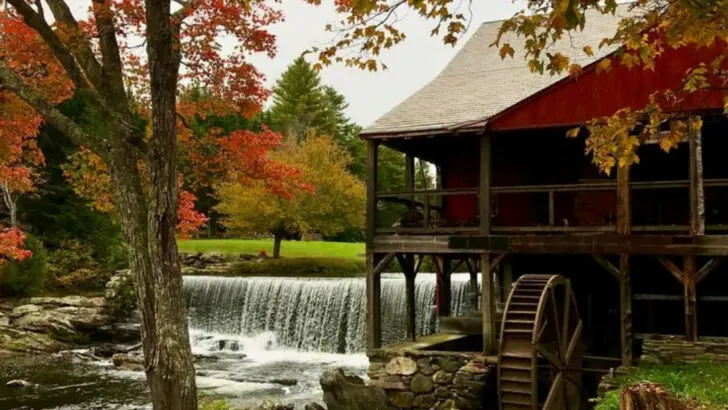Some roads just get under your skin—in the best way. Vermont’s Route 100 isn’t flashy. It doesn’t race along cliffs or hug the ocean. But it winds, rolls, and meanders through towns so charming you’ll think you dreamed them up. One minute you’re passing a maple syrup stand. The next, a white-steepled church or a covered bridge straight out of a postcard. And the best part? It feels slow—in all the ways you need it to. This isn’t just a scenic drive. It’s a long, deep breath with your windows down and your phone forgotten.
Wilmington – Early Blooms and Mountain Shade
Wilmington greets travelers with its early spring charm, where violas and pansies burst in village planters. Just a stone’s throw from town, shady roadsides transition into lush hardwood forests. Ferns carpet the ground beneath towering trees, and trillium flowers peek through the underbrush, offering a hint of the vibrancy to come. The blend of cool-weather blooms and emerging greenery creates a serene and refreshing atmosphere, perfect for a leisurely stroll. Wilmington offers an inviting start to your Route 100 adventure, as nature begins to wake from its winter slumber, showcasing its resilience and beauty.
Weston – Cottage Gardens and Backyard Herbs
Weston is a gardener’s delight, where the spirit of cottage gardens flourishes in every yard. Vibrant phlox, towering hollyhocks, and colorful bee balm paint a picture of rustic charm. Herbs like mint and chives nestle close to porches, mingling with edible flowers to create a fragrant tapestry. The town’s floral abundance reflects a deep-rooted appreciation for nature’s bounty. In Weston, every garden tells a story, and every plant is a part of the community’s living tapestry. This picturesque town invites you to pause, breathe in the scents, and savor the artistry of its gardens.
Ludlow – Slope Gardens and Stone Walls
Ludlow’s landscape is a tribute to the art of gardening amidst slopes. Stone-bordered gardens hug the hillsides, with hostas unfurling their broad leaves in the shade. Daylilies add bursts of color, while Solomon’s seal lends elegance to the ensemble. Retaining walls not only manage runoff but also create layered zones where plants thrive. This harmonious blend of natural and crafted elements speaks to Ludlow’s resourcefulness. As you explore, you’ll find each garden a testament to the town’s ingenuity and the beauty that comes from working with the land’s natural contours.
Plymouth Notch – Apple Trees and Old-Fashioned Perennials
In Plymouth Notch, history blooms among heritage apple trees and old-fashioned perennials. This preserved village, birthplace of Calvin Coolidge, carries whispers of a bygone era. Peonies and black-eyed Susans line farmhouses, exuding a nostalgic charm. Rhubarb grows sturdy by the doors, a nod to practical beauty. Walking here is like stepping back in time, where each plant holds a piece of history. The scenery captures the essence of early-20th-century gardens, merging tradition with the timeless allure of nature’s cycles. Plymouth Notch is a living museum of horticultural heritage.
Killington – High-Elevation Shrubs and Cool Summers
Killington stands apart with its high-elevation gardens, where the air is crisp and blooms unfold in their own time. Mountain ash and hobblebush line the roads, creating a verdant corridor. The cool temperatures mean that gardens here may still harbor late lilacs or the first coneflowers of summer. These delayed blooms add a unique charm, making Killington a refreshing retreat. The high-altitude setting not only affects the flora but also casts a spell of tranquility, inviting visitors to linger and enjoy the slow dance of seasons in this elevated haven.
Rochester – Riverbanks and Wild Meadows
Rochester enchants with its riverbank meadows, where nature thrives in wild abandon. Alongside the White River, grassy fields burst with Queen Anne’s lace, goldenrod, and milkweed. Monarch butterflies flutter, painting the air with their delicate wings, while crickets provide the soundtrack of warm afternoons. This natural symphony celebrates the untamed beauty of Vermont. Rochester’s meadows are a reminder of nature’s artistry, where each plant and creature plays a role. It’s an invitation to witness the simple yet profound elegance of a landscape left to its own devices, untouched and alive.
Warren – Mountain Meadows and Native Grasses
In Warren, mountain meadows unfold like a painter’s canvas, dappled with native grasses. Switchgrass sways under cooler skies, while asters and New England blazing star add strokes of vibrant color. There’s a peace to this part of Route 100, especially in early fall. The grasses bend gracefully, whispering secrets of the mountains. This serene landscape invites reflection and appreciation for Vermont’s natural splendor. As the seasons transition, Warren’s fields stand as symbols of resilience and beauty, offering a tranquil pause on your journey through the heart of the Green Mountains.
Waitsfield – Farmstands and Edible Plant Beds
In Waitsfield, local farmstands delight the senses by artfully mingling flowers with vegetables. Imagine zinnias flourishing beside kale, marigolds nestling next to tomatoes. These vibrant combinations beckon visitors to pause and appreciate nature’s bounty. In the village, raised beds brim with nasturtiums, chard, and borage, particularly during midsummer, creating a tapestry of colors and textures. This charming blend of flora not only beautifies the landscape but also reflects the town’s commitment to sustainable and local agriculture. It’s a community effort that enchants both residents and travelers alike, making Waitsfield a must-see stop along Route 100.
Waterbury – Maple Groves and Mossy Trails
Waterbury offers a refreshing escape with its renowned sugar maples, which provide not only breathtaking fall foliage but also welcome summer shade. Beneath these towering trees, moss thrives alongside wood sorrel and woodland violets, creating a lush, green carpet. Trails just off Route 100 invite hikers to explore, revealing hidden pockets of tranquility that remain cool and vibrant, even during dry spells. This area’s natural beauty is complemented by a commitment to preserving its unique ecosystem, making Waterbury a haven for those seeking peace and a deeper connection with nature.
Stowe – Forest Gardens and Carefully Tended Yards
Stowe enchants visitors with its fusion of cultivated gardens and wild forest backdrops. Gardens often showcase cool-season plants such as lungwort, lady’s mantle, and bleeding heart, providing a unique visual experience. Locals take pride in their shady beds, tending them with meticulous care, ensuring every plant thrives. The seamless transition from manicured lawns to forested areas blurs the line between human cultivation and the wild, offering a harmonious blend that captivates the senses. This town’s gardens are a testament to the community’s love for nature and dedication to preserving its idyllic setting.
Morrisville – Community Plots and Native Flower Mixes
Morrisville is a community that thrives on collaboration and gardening. The town supports community gardening initiatives, where plots flourish with a vibrant mix of Echinacea, yarrow, and black-eyed Susans. These gardens are more than just a feast for the eyes; they are vital sanctuaries for pollinators. Benches placed nearby invite visitors to pause and appreciate the quiet beauty and industrious buzz of bees and butterflies. This blend of human and natural effort fosters a unique sense of place, where community ties are strengthened through the shared joy of gardening.
Eden – Backroads and Wild Raspberry Canes
Eden captivates with its quiet backroads, where nature reigns supreme. Wild raspberry brambles line the roadside, offering sweet surprises for those who linger. Goldenrod and meadowsweet add splashes of yellow and white, painting the landscape with an untamed beauty. This area feels softer, with fewer fences to constrain the natural spread of flora. The gentle sway of plants in the breeze provides a soothing soundtrack for travelers. Eden’s unspoiled edges are a testament to Vermont’s wild side, inviting exploration and appreciation for its simple, yet profound, beauty.
Lowell – Wetlands and Willow Shrubs
In Lowell, wetlands create a distinctive landscape teeming with life. Willows and cattails thrive near creeks and low bridges, crafting a scene of serene beauty. These areas, dotted with lush vegetation, provide habitats for diverse wildlife. Visitors are treated to the sight of graceful willows swaying in the breeze, their branches dipping towards the water. The vast open sky above adds to the feeling of spaciousness and tranquility. This blend of water and sky offers a refreshing contrast to the dense forests along Route 100, making Lowell a unique stop on the journey.
Newport – Lakeside Gardens and Cool Breezes
At the northern end of Route 100, Newport greets visitors with its lakeside charm. Lake Memphremagog provides a backdrop of cool breezes and stunning vistas. Gardens here, adorned with sedum, hydrangea, and ornamental grasses, invite leisurely strolls along the water’s edge. These plantings are designed to complement the natural beauty of the lake, offering both aesthetic pleasure and a habitat for local wildlife. The interplay of water and greenery creates a tranquil atmosphere, perfect for reflection and relaxation. Newport’s gardens serve as a serene conclusion to the journey along this scenic route.

